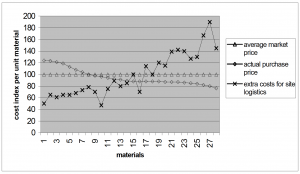I learned early on as a young U.S. Marine logistics officer that operations drive logistics. I had to be proactive and actively collaborate with my supported units during pre-execution to ensure timely and accurate support.
It is a similar concept in construction. Project Managers are the logisticians of the jobsite, and logisticians have to understand demand signals.
How does a project manager better understand demand signals? The real pros will validate the project’s procurement log against a superintendent’s six-week lookahead once a week and have a daily 15-minute procurement sync with the team. Check out Jason Schroeder’s podcast on the topic, #398. His take is spot-on.
How do we begin to match demand signals with the supply chain? Let’s start with ‘Role 1’; focus on the interface between the supply chain and the construction site. This refers to a better understanding of what, when, and how requirements are to be delivered.
Forecast as far out as possible, as detailed as possible. The effectiveness of a forecast is directly proportional to the amount of planning done on the front end. A proper phase planning session will get you there.
As lead times start returning to normal, the contractors that can forecast instead of relying on bulk buys will reap the benefit. The proof is visible if you look at any construction project in your area. Project managers are locking in price and predictability early but at the expense of the jobsite. While this approach may look like the best financial decision on paper, there is never a zero-cost solution to bulk procurement due to the amount of time it takes to sort materials and get them the last 100 yards to the final destination. Not to mention the risk of damaged material. Good luck getting a warranty on your roofing system if the material has been in the weather for two months. As we move away from having to do bulk procurement upfront, project teams will have to go back to the basics and resume (or start) managing procurement forecasts.
To illustrate my point, here is a chart from Ruben Vrijhoef and Koskela’s paper I highlighted in the first post of the series.

Sure, per unit price goes down with higher volumes, but the cost to manage site logistics goes way up.
The first step to proper forecasting is to know the project. More often than not, you are going to have your master schedule, and then you are going to have what is happening on the jobsite. Your planning space is how you proactively generate and communicate demand signals. From a supply chain perspective, your master schedule is useful to help build the procurement log, but it has to constantly be validated by what is being planned and executed. I can’t say this loud enough. Superintendents: use Touchplan religiously to manage your lookahead because it impacts more than just what your trades are doing. Trade and GC PMs plus Owners need to understand how planned work is tied to the procurement forecast. Pro Tip: Use a custom field that links directly to an item on the procurement log or, even better, to a supply chain management platform like SiteSense by Intelliwave.
You might have late deliveries that result in a late project if the team has to wait for a bi-weekly schedule update to understand and act on demand signals—plan and track progress on weekly and daily intervals. Your job will flow not only because your trades are aligned but your supply chain as well.
If you missed the first post in this series, you can read it here.






